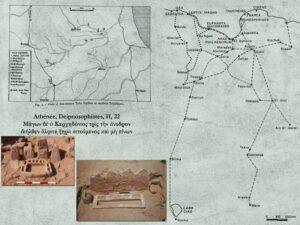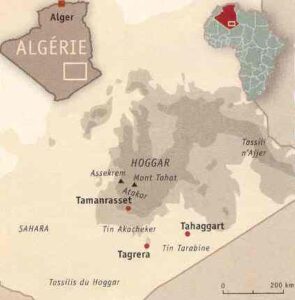The natural resources that can be found in Libyan territory are of a different nature from those found along the Atlas Mountain system, which stretches some 2,500 km between Tunisia, Algeria, and Morocco.
Herodotus (IV, 184) reports that ten days’ march from the land of the Garamantes there is a hill of salt and water inhabited by the people of the Ataranti; another ten days’ march further on there is another hill of salt and water inhabited by the Atlantes, who live in the region of the Atlas, “narrow and round”. The location and identification of this region and these peoples are debated. In any case, Arab sources seem to confirm that the stages mentioned by Herodotus correspond to the caravan stops at Tassili and Hoggar, the Adar to Gao. In particular, the territory of the Atlantes is in the Hoggar, whose mountains form the highest region of the southern belt of the Sahara.
This seems to confirm that salt mines and the men who worked them, as well as the existence of a “trans-Saharan trade system”, were already known in the 5th century BC. The Hoggar is crossed by the Igharghar oued, which makes these high valleys relatively rich in pasture. Between the Jebel Ahaggar and the Tassili lies the great salt marsh of the sebkha of Amadghor, also a modern meeting point between Saharan nomads and Sudanese traders.
The sebkha of Amadghor must once have been an inland lake from which a great river, the Igharghar, flowed northwards. One of the caravan routes from Ourgla to Agades passed through the sebkha d’Amadghor (the Amadror salt pans), one
of the richest and largest salt deposits in the Sahara, located halfway between the Algerian tells and the village of Haoussa, in the modern territory of the Touareg Ahaggar. Also of great interest is the Tidikelt salt mine, near the In Salah oasis, which is still one of the stops on the tramsharian trade route between Timbouctou and the Mediterranean coast.
The location of the salt pans in the Ahaggar, which were probably exploited in ancient times, makes it plausible that there was a route from Biskra (Vescara), through the oases between Touggourt and Ouargla, across the Sahara to the Hoggar in a north-south direction, where it probably met the other east-west route, which started from the coast of Tripolitania, from Sabratha.
Moreover, indirect evidence, such as the presence of Getuli and Garamanti mercenaries in the Carthaginian army and elsewhere, suggests at least some knowledge of these regions, which were otherwise almost unknown at the time of the first contact with the Roman world. Another problem is to understand how and by what routes this knowledge was transmitted, most likely through the Berber populations of the highlands.



